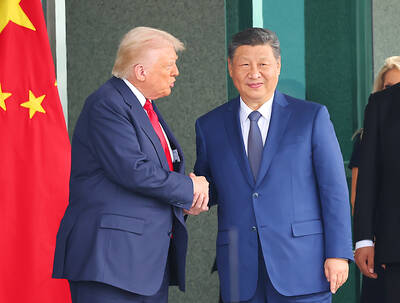Shortages of empty containers and voyage cancelations could persist for several more months and drive up freight rates, with the arrival of the peak sales season and lingering congestion at ports in Europe, the US and China, said the local branch of DB Schenker, a leader in supply chain management and logistics solutions.
“Empty container shortages are worsened by port congestion in Europe and the US, and recently, by China’s Yantian port backlog,” Schenker Taiwan vice president Antoine Bouin told an online news conference on Monday.
Ongoing disruptions at ports in southern China would have a more serious effect on the market than the earlier Suez Canal incident in late March, as Yantian port in Guangdong Province’s Shenzhen handles 24 percent of China’s total exports, Bouin said.

Photo: AFP
A COVID-19 outbreak caused Yantian port to close for a week last month, and subsequent controls and access limits have seriously reduced operations, he said, adding that congestion at Yantian spilled over to other ports in Guangdong and Asia.
As of last week, more than 50 vessels were waiting to dock, and 300 vessels skipped Yantian between June 1 and 15, he said.
The port is back at normal capacity, but the backlog is likely to take several weeks to clear, Bouin said.
Significant flow imbalances also added to shipping chaos in light of high volumes moving from Asia to Europe and the US, but low volumes coming from Europe and the US to Asia, he said.
Port congestion, berthing delays, flow imbalances and the slow return of empty containers have caused shipping lines to skip some of their regular trips and pushed global shipping schedule reliability to a historic low, he said.
Freight rates are likely to remain high for the rest of this year, Bouin said.
For Taiwan, freight rates and the container situation would be slightly better, as the arrival of new megaships at Evergreen Marine Corp (長榮海運) would help, he said.
Bouin said that companies should draw up accurate forecasts of volume for next quarter, plan together with shipping lines and make capacity commitments to secure space.

RUN IT BACK: A succesful first project working with hyperscalers to design chips encouraged MediaTek to start a second project, aiming to hit stride in 2028 MediaTek Inc (聯發科), the world’s biggest smartphone chip supplier, yesterday said it is engaging a second hyperscaler to help design artificial intelligence (AI) accelerators used in data centers following a similar project expected to generate revenue streams soon. The first AI accelerator project is to bring in US$1 billion revenue next year and several billion US dollars more in 2027, MediaTek chief executive officer Rick Tsai (蔡力行) told a virtual investor conference yesterday. The second AI accelerator project is expected to contribute to revenue beginning in 2028, Tsai said. MediaTek yesterday raised its revenue forecast for the global AI accelerator used

Taiwan Semiconductor Manufacturing Co (TSMC, 台積電) has secured three construction permits for its plan to build a state-of-the-art A14 wafer fab in Taichung, and is likely to start construction soon, the Central Taiwan Science Park Bureau said yesterday. Speaking with CNA, Wang Chun-chieh (王俊傑), deputy director general of the science park bureau, said the world’s largest contract chipmaker has received three construction permits — one to build a fab to roll out sophisticated chips, another to build a central utility plant to provide water and electricity for the facility and the other to build three office buildings. With the three permits, TSMC

TEMPORARY TRUCE: China has made concessions to ease rare earth trade controls, among others, while Washington holds fire on a 100% tariff on all Chinese goods China is effectively suspending implementation of additional export controls on rare earth metals and terminating investigations targeting US companies in the semiconductor supply chain, the White House announced. The White House on Saturday issued a fact sheet outlining some details of the trade pact agreed to earlier in the week by US President Donald Trump and Chinese President Xi Jinping (習近平) that aimed to ease tensions between the world’s two largest economies. Under the deal, China is to issue general licenses valid for exports of rare earths, gallium, germanium, antimony and graphite “for the benefit of US end users and their suppliers

Dutch chipmaker Nexperia BV’s China unit yesterday said that it had established sufficient inventories of finished goods and works-in-progress, and that its supply chain remained secure and stable after its parent halted wafer supplies. The Dutch company suspended supplies of wafers to its Chinese assembly plant a week ago, calling it “a direct consequence of the local management’s recent failure to comply with the agreed contractual payment terms,” Reuters reported on Friday last week. Its China unit called Nexperia’s suspension “unilateral” and “extremely irresponsible,” adding that the Dutch parent’s claim about contractual payment was “misleading and highly deceptive,” according to a statement